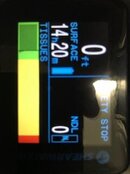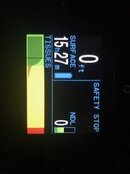I'm always out of the pool 24hrs before take off and I've never been bent... I have cut it close, 12:30 pm exit, 2pm flight the following day. The computer was cleared by 18hrs but I'll call the extra 6 insurance.
You are using an out of date browser. It may not display this or other websites correctly.
You should upgrade or use an alternative browser.
You should upgrade or use an alternative browser.
Why the wait to fly?
- Thread starter MtnDiverColorado
- Start date
Please register or login
Welcome to ScubaBoard, the world's largest scuba diving community. Registration is not required to read the forums, but we encourage you to join. Joining has its benefits and enables you to participate in the discussions.
Benefits of registering include
- Ability to post and comment on topics and discussions.
- A Free photo gallery to share your dive photos with the world.
- You can make this box go away
I think your question has been answered in several posts above.OK, let’s do a practical calculation. Let’s say I’m planning on a lovely trip to the Bahamas. I would be diving for 3 days, doing AM & PM 2 tank dives each day, for a total of 12 dives. Assuming I’m out of the water by about 3:30-4:00 on the third day, and that I’ve followed conservative, no deco dives to 80-90 ft max for all three days, can I assume I’ll be safe to fly early the following afternoon, or is my accumulated N2 load sufficient that I should wait a full 24 hours (or more) by the clock? Reading this thread makes me think an earlier flight should be fine, but what think ye?

I have to disagree as a practical matter. The climb indicator on common commercial jets (e.g., MD80) tops out at 6000 ft/min. That is a water equivalent rate of 6.6 ft/min, which is well under the 30 ft/min ascent rate we feel is safe for diving.Going to altitude is analogous to ascent rate and ascent rate matters.
I will concede that ascent rate plays a tiny role in that the inert tissue pressure won't appreciably decrease during the climb time of an airplane. However, the primary concern is whether the ambient pressure drops significantly lower than that of your tissues.
You guys are kind of missing the point with these pressure calculations. The real reason to wait 12-24 hours before flying is that the first symptom of DCS is denial. "I'm not bent, I just have a sore muscle from weightlifting yesterday!" Waiting a bit gives you time to get over the denial and admit that you need some treatment.
On the other hand, if you do the correct deco and legitimately have no symptoms then you can go straight from the dive boat to the airport. Which I have done a few times. Any remaining bubbles will be resolved by the time you actually take off. But I'm not recommending that to anyone else, so don't jump all over me.
On the other hand, if you do the correct deco and legitimately have no symptoms then you can go straight from the dive boat to the airport. Which I have done a few times. Any remaining bubbles will be resolved by the time you actually take off. But I'm not recommending that to anyone else, so don't jump all over me.
garyh
Contributor
- Messages
- 218
- Reaction score
- 109
- Location
- Peterborough Ontario Canada
- # of dives
- I just don't log dives
Not worth messing with or the risk. Brings back memories. Spent about 3 weeks down in north central FL maybe 15/16 years back. A lot of aggressive dives, Trimix, Diepolder, Eagles nest and others, 1/2 dives a day. Day I was supposed to head home my dive buddy wanted to do Little River b4 I left. Ok I'll pack up we can do the dive and i will head out from there. Did the dive and started the drive home, felt fine. All I can remember is passing through the mountains in TN and reading the u r at elevation xxxx in the middle of the night and thinking I dont feel so great. Ended up driving the rest of the way home breathing down whatever gas I had in the car with the most o2 content with a reg in my mouth. Managed to get home and spent the next 3 days doing chamber rides down at Toronto General. Probably a 3 month recovery beyond that. Cost me a trip to the A Doria.
kaylee_ann
crazy diver
Huh? I was under the impression that your tissues are still saturated above normal sea level saturation for around a day or so, depending on your dive profile. When you go further above sea level, you won't be decompressing adequately, and could still form bubbles and get bent. You're under less pressure, like when you ascend in the water.You guys are kind of missing the point with these pressure calculations. The real reason to wait 12-24 hours before flying is that the first symptom of DCS is denial. "I'm not bent, I just have a sore muscle from weightlifting yesterday!" Waiting a bit gives you time to get over the denial and admit that you need some treatment.
On the other hand, if you do the correct deco and legitimately have no symptoms then you can go straight from the dive boat to the airport. Which I have done a few times. Any remaining bubbles will be resolved by the time you actually take off. But I'm not recommending that to anyone else, so don't jump all over me.
edit- to be more specific, even if you feel totally fine on land (not from denial), you can have big time issues in the air. deco algorithms don't account for the ascent above sea level pressure.
And I don't want to imagine the hellhole of cabin pressure loss.
kaylee_ann
crazy diver
Also, I'm sure there's people out there who'd deny they got bent on a plane too.
*depending on severity*
*depending on severity*
CycleCat
Contributor
The other issue could be the little puddle jumpers you take from dive resorts to the bigger airport might not have pressurized cabins.
kaylee_ann
crazy diver
Commercial jets do, but I'm not sure that even the small 6-8-seater planes have them. I wouldn't be surprised if the tiny transport ones at resorts don't.The other issue could be the little puddle jumpers you take from dive resorts to the bigger airport might not have pressurized cabins.
Similar threads
- Question
- Replies
- 34
- Views
- 3,594
- Replies
- 7
- Views
- 766





